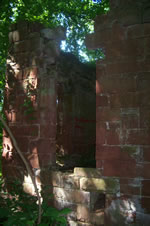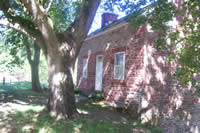The Two-in-One Structure
By Ranger Lisa
The C&O Canal had 11 aqueducts and 74 lift locks... but one was both a lift lock and an aqueduct! This engineering marvel is located at mile 22.7, at the mouth of Seneca Creek.
My first visit to Lock 24 (called Riley's Lock after the family that operated the lock) and the Seneca Aqueduct followed a flood event. I had been sent to assess damage and help remove flood debris. The power of the water was amazing, stacking tons of debris behind the aqueduct. However, as a historian, I was equally astounded at the structure itself and found myself looking at it from all angles and imagining boats crossing Seneca Creek while locking up- just incredible! Long before this visit, I had heard of and read about this place, but it wasn't until I saw it in person that I truly appreciated it as the engineering feat it was.
In 1830, just two years after the Canal's construction began, the builders halted at the mouth of Seneca Creek. For a short time, it was the farthest point west you could travel on the C&O Canal. Here, the canal company faced two challenges: the crossing of Seneca Creek, requiring an aqueduct, and a change in elevation, requiring a lift lock. An aqueduct is, essentially, a water-filled bridge that allowed boats to cross creeks safely. A lift lock is a water filled chamber used to raise or lower boats. The engineers decided to build one structure which encompassed both an aqueduct and a lock. Considering as I did the reality that everything seen was built by hand, without any of the modern construction equipment we now take for granted, it was a truly amazing feat! It was completed in April, 1832 at a cost of $32,000.
- Looking across the Seneca Aqueduct, the Potomac River spreads widely, taking in the waters of Seneca Creek as well as the overflow of the canal from a waste weir. Credit: Chesapeake & Ohio Canal National Historical Park
- Lockkeeper families living at Lock 24 had to contend with the flooding of both the Potomac River and Seneca Creek. Credit: Chesapeake & Ohio Canal National Historical Park
- Tourists traveling along the canal take a break at Lock 24 before continuing on their journey upstream. Credit: Consolidation Coal Company Collection, Chesapeake & Ohio Canal National Historical Park
- Seneca Aqueduct Credit: Doug Zveare
- Even an overcast winter day cannot diminish the warm glow of the red sandstone exterior of the lockhouse. The stones used to build both the lockhouse and the aqueduct were quarried a short distance upstream. Credit: Doug Zveare
- Rileys lockhouse is open for tours on Saturdays during the spring and fall. Local Girl Scouts in period dress guide visitors through the historic home. Credit: Chesapeake & Ohio Canal National Historical Park

Seneca Stonecutting Mill
Milepost 22.7

Rileys Lockhouse
Milepost 22.8

Seneca Creek State Park
Milepost











